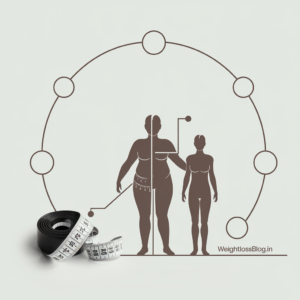How to Lose Weight with the CICO Diet: A Step-by-Step Guide for Beginners
Introduction to the CICO Diet
The CICO Diet, which stands for “Calories In, Calories Out,” is a simple and flexible weight loss plan based on the principle of energy balance. Unlike many other diets that focus on specific food groups or eating patterns, the CICO Diet revolves around  the idea that as long as you consume fewer calories than your body burns, you will lose weight. This approach allows individuals to eat virtually any food, as long as they stay within their daily calorie limit.
the idea that as long as you consume fewer calories than your body burns, you will lose weight. This approach allows individuals to eat virtually any food, as long as they stay within their daily calorie limit.
The CICO Diet is popular because of its simplicity and flexibility, making it a great option for people who want to lose weight without giving up their favorite foods. By focusing on calorie control and understanding how many calories your body needs to function, you can create a calorie deficit and achieve weight loss. In this guide, we’ll explore how the CICO Diet works, its benefits, and how to follow the CICO diet for weight loss.
How the CICO Diet Works for Weight Loss
The CICO Diet is based on the concept of energy balance, which is the relationship between the calories you consume (calories in) and the calories your body burns (calories out). To lose weight, you need to create a calorie deficit, which means consuming fewer calories than your body needs to maintain its current weight. The size of the calorie deficit will determine how quickly you lose weight.
The key to success on the CICO Diet is accurately tracking your calorie intake and understanding your body’s calorie expenditure. To do this, you’ll need to calculate your total daily energy expenditure (TDEE), which is the number of calories your body burns in a day, including your basal metabolic rate (BMR) and any physical activity. Once you know your TDEE, you can set a calorie limit that is below this number to create a deficit and lose weight.
Steps to Follow the CICO Diet
- Step 1: Calculate Your TDEE: Use an online calculator or consult a nutritionist to determine your total daily energy expenditure (TDEE). This number will vary based on factors such as age, weight, gender, and activity level.
- Step 2: Set Your Calorie Limit: Once you know your TDEE, set a daily calorie limit that is 500-1000 calories below your TDEE. This will create a calorie deficit that can help you lose 1-2 pounds per week.
- Step 3: Track Your Calories: Use a food diary, mobile app, or calorie tracking tool to log everything you eat and drink throughout the day. Be sure to measure portion sizes accurately to ensure you’re
 staying within your calorie limit.
staying within your calorie limit. - Step 4: Stay Active: Physical activity can help increase your calorie expenditure, allowing for more flexibility in your diet. Incorporating regular exercise, such as walking, cycling, or strength training, can help you burn more calories and achieve faster results.
Benefits of the CICO Diet for Weight Loss and Health
The CICO Diet offers several benefits for weight loss and overall health. Here are some of the key advantages:
1. Flexibility in Food Choices
One of the most appealing aspects of the CICO Diet is its flexibility. Since the diet is based on calorie control rather than specific food restrictions, you can eat a wide variety of foods as long as you stay within your calorie limit. This makes the CICO Diet more sustainable for many people, as they don’t have to give up their favorite treats or follow strict meal plans.
2. Simple and Easy to Follow
The CICO Diet is straightforward and easy to understand, making it accessible for beginners. There are no complicated rules or food restrictions to follow—just track your calories and maintain a calorie deficit. This simplicity can make it easier to stick to the diet long-term.
3. Promotes Awareness of Eating Habits
By tracking your calorie intake, the CICO Diet encourages you to become more mindful of your eating habits. You’ll start to notice how many calories are in certain foods, which can help you make healthier choices and control portion sizes. This increased awareness can lead to better long-term eating habits and more sustainable weight loss.
4. Can Be Combined with Other Diets
The CICO Diet can easily be combined with other eating patterns, such as low-carb, intermittent fasting, or plant-based diets. As long as you maintain  a calorie deficit, you can choose the foods that work best for your lifestyle and preferences. This flexibility makes the CICO Diet a versatile option for many people.
a calorie deficit, you can choose the foods that work best for your lifestyle and preferences. This flexibility makes the CICO Diet a versatile option for many people.
Potential Drawbacks of the CICO Diet
While the CICO Diet offers many benefits, there are some potential drawbacks to consider:
1. Focuses Solely on Calories
One of the main criticisms of the CICO Diet is that it focuses solely on calories and doesn’t take into account the nutritional quality of foods. While it’s possible to lose weight on the CICO Diet by eating junk food in moderation, this approach may not provide your body with the essential nutrients it needs to stay healthy. For optimal health, it’s important to choose nutrient-dense foods that provide vitamins, minerals, and fiber.
2. Requires Consistent Tracking
The CICO Diet relies heavily on calorie tracking, which can be time-consuming and tedious for some people. It’s important to be diligent about measuring portion sizes and logging everything you eat to ensure you’re staying within your calorie limit. This level of tracking may not be sustainable for everyone, especially in the long term.
3. May Not Address Emotional Eating
While the CICO Diet is effective for creating a calorie deficit, it may not address underlying emotional or psychological factors that contribute to overeating. If you struggle with emotional eating, stress eating, or food addiction, the CICO Diet alone may not be enough to help you achieve long-term weight loss success. In these cases, additional support from a therapist or nutritionist may be beneficial.
Tips for Success on the CICO Diet
To maximize your success on the CICO Diet and achieve your weight loss goals, follow these practical tips:
1. Plan Your Meals Ahead of Time
Planning your meals and snacks ahead of time can help you stay within your calorie limit and avoid impulsive eating. Prepare healthy, low-calorie meals in advance, and keep healthy snacks on hand to avoid reaching for high-calorie junk food when you’re hungry.
2. Focus on Nutrient-Dense Foods
While the CICO Diet allows you to eat a variety of foods, it’s important to focus on nutrient-dense options that provide essential vitamins, minerals, and fiber. Choose foods like fruits, vegetables, lean proteins, whole grains, and healthy fats to support your overall health while staying within your calorie limit.
3. Use Technology to Track Calories
There are many apps and tools available to help you track your calorie intake more easily. Apps like MyFitnessPal, LoseIt!, and Cronometer allow you to log your meals, track your calories, and monitor your progress over time. These tools can make calorie tracking more convenient and help you stay on track with your goals.
4. Stay Active
Incorporating physical activity into your routine can help increase your calorie expenditure and make it easier to maintain a calorie deficit. Aim for at least 150 minutes of moderate exercise per week, such as brisk walking, cycling, or swimming. Strength training exercises can also help build muscle and boost your metabolism.
5. Be Patient with the Process
Weight loss on the CICO Diet may be gradual, especially if you’re aiming for a modest calorie deficit. It’s important to be patient and stay consistent with your calorie tracking and healthy habits. Remember that sustainable weight loss takes time, and slow, steady progress is more likely to lead to long-term success.
Scientific Evidence and Case Studies
The CICO Diet is based on the principle of energy balance, which has been supported by numerous scientific studies. Research has consistently shown that creating a calorie deficit is the most effective way to lose weight, regardless of the macronutrient composition of the diet. A study published in the New England Journal of Medicine found that calorie restriction was the primary factor in weight loss, regardless of whether participants followed a low-fat, low-carb, or high-protein diet.
Additionally, research on flexible dieting approaches like CICO has shown that allowing for flexibility in food choices can improve adherence to a weight loss plan, making it easier for individuals to stick to their diet in the long term.
Who Should Try the CICO Diet?
The CICO Diet is a good option for individuals who:
- Are looking for a simple, flexible approach to weight loss.
- Prefer to eat a wide variety of foods without strict restrictions.
- Are willing to track their calorie intake consistently.
- Want to combine their diet with other eating patterns, such as low-carb or intermittent fasting.
Who Should Avoid the CICO Diet?
While the CICO Diet can work for many people, it may not be suitable for everyone. You should avoid the diet if you:
- Have a history of disordered eating or food addiction.
- Prefer a structured diet with specific guidelines on what to eat.
- Struggle with calorie tracking or find it difficult to measure portion sizes accurately.
Conclusion
The CICO Diet is a flexible, calorie-focused approach to weight loss that allows individuals to eat a wide variety of foods while maintaining a calorie deficit. By tracking your calorie intake, staying active, and focusing on nutrient-dense foods, you can achieve sustainable weight loss and improve your overall health. While the CICO Diet offers many benefits, it’s important to be aware of its potential drawbacks and to consult with a healthcare provider if you have any concerns about your dietary needs.